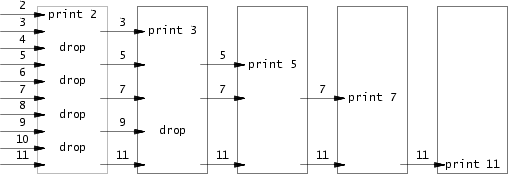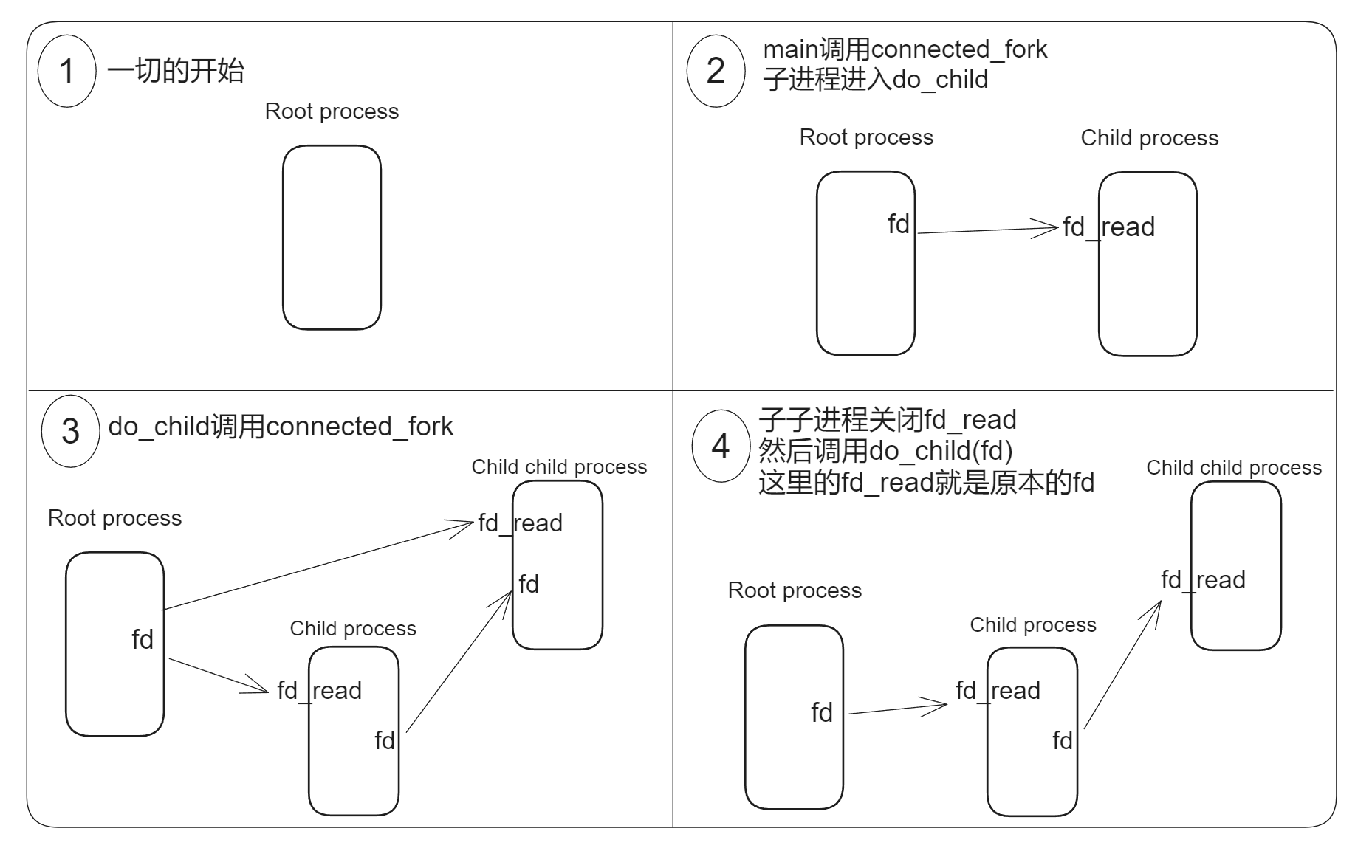在开始 lab 之前,我们先来解释一下为什么我们写的代码能直接在 xv6 的 shell 里执行。我们来看看 sh.c 的部分代码:
1 2 3 4 5 6 7 8 9 10 11 12 13 while (getcmd(buf, sizeof (buf)) >= 0 ) { if (buf[0 ] == 'c' && buf[1 ] == 'd' && buf[2 ] == ' ' ) { buf[strlen (buf) - 1 ] = 0 ; if (chdir(buf + 3 ) < 0 ) fprintf (2 , "cannot cd %s\n" , buf + 3 ); continue ; } if (fork1() == 0 ) runcmd(parsecmd(buf)); wait(0 ); }
从这里我们看出,shell通过fork子进程来执行命令。如果进一步看看 runcmd 函数,就会发现它调用了 exec,因此 shell 能执行用户写的代码。
有趣的是,从这段代码里我们也能看出 cd 是内置在 shell 里的命令,这是因为 cd 改变了shell自身的工作目录。
sleep 这题让我们简单熟悉下接口。其实这里用 printf 更易读,不过我当时做的时候没发现有 printf
1 2 3 4 5 6 7 8 9 10 11 12 13 #include "kernel/types.h" #include "user/user.h" #include "kernel/fcntl.h" int main (int argc, char *argv[]) { char *errmsg = "sleep: missing operand\n" ; if (argc != 2 ) { write(1 , errmsg, strlen (errmsg)); exit (1 ); } sleep(atoi(argv[1 ])); exit (0 ); }
pingpong 这题让我们接触一下管道的使用,难者不会,会者不难
1 2 3 4 5 6 7 8 9 10 11 12 13 14 15 16 17 18 19 20 21 22 23 24 25 26 27 28 29 30 31 32 33 34 35 36 #include "kernel/types.h" #include "user/user.h" #include "kernel/fcntl.h" int main () { char buf[512 ]; int p_parent_sender[2 ]; int p_child_sender[2 ]; pipe(p_parent_sender); pipe(p_child_sender); if (fork() == 0 ) { read(p_parent_sender[0 ], buf, 2 ); printf ("%d: received ping\n" , getpid()); write(p_child_sender[1 ], buf, 2 ); close(p_parent_sender[0 ]); close(p_parent_sender[1 ]); close(p_child_sender[0 ]); close(p_child_sender[1 ]); exit (0 ); } write(p_parent_sender[1 ], buf, 2 ); read(p_child_sender[0 ], buf, 2 ); printf ("%d: received pong\n" , getpid()); close(p_parent_sender[0 ]); close(p_parent_sender[1 ]); close(p_child_sender[0 ]); close(p_child_sender[1 ]); exit (0 ); }
primes 这题很有趣,是一个并发素数筛法。这个算法理论上是可以提高效率的,毕竟在运行了一段时间后,各个进程里都有一些数等待筛选,这时各个进程在同时用自己的素数筛选输入的数。
网上很多代码都是2020版的,当时的要求是找出 2-35 间的素数。这些代码能过老版本的要求,但过不了2024版要求的 2-280。我认真看了一两份代码,发现它们在用 fork 创建子进程的子进程后,忘了关闭子子进程的连接到父进程的描述符。可以看下面示意图的第三个框,这些代码忘了关闭 child child process 的 fd_read.
我画了示意图来解释我的代码~
1 2 3 4 5 6 7 8 9 10 11 12 13 14 15 16 17 18 19 20 21 22 23 24 25 26 27 28 29 30 31 32 33 34 35 36 37 38 39 40 41 42 43 44 45 46 47 48 49 50 51 52 53 54 55 56 57 58 59 60 61 62 63 64 65 66 67 68 69 70 71 72 73 74 75 76 77 78 79 80 81 82 83 84 85 86 87 88 89 90 91 92 93 94 95 #include "kernel/types.h" #include "kernel/stat.h" #include "user/user.h" const int NUM = 280 ;int connected_fork (int *) ;void do_child (int ) ;int main () { int pid; int fd = -1 ; if ((pid = connected_fork(&fd)) == 0 ) { do_child(fd); exit (0 ); } int n; for (n = 2 ; n <= NUM; n++) { write(fd, (void *)&n, sizeof (int )); } close(fd); wait(0 ); exit (0 ); } int connected_fork (int *fd) { int p[2 ]; pipe(p); int pid; if ((pid = fork()) == 0 ) { close(p[1 ]); *fd = p[0 ]; } else { close(p[0 ]); *fd = p[1 ]; } return pid; } void do_child (int fd_read) { int n = -1 ; int prime = -1 ; int fd = -1 ; while (read(fd_read, (void *)&n, sizeof (int )) > 0 ) { if (prime == -1 ) { prime = n; printf ("prime %d\n" , prime); } if ((n % prime) != 0 ) { if (fd == -1 && connected_fork(&fd) == 0 ) { close(fd_read); do_child(fd); return ; } write(fd, (void *)&n, sizeof (int )); } } close(fd_read); if (fd == -1 ) { return ; } close(fd); wait(0 ); }
find 在 ls.c 的基础上稍微改改就好了,要注意的是递归时不要递归进 “.” 和 “..” 两个文件夹
我们实现的 find <path> <name> 的功能和 Linux 里的 find <path> -name <name> 一致
1 2 3 4 5 6 7 8 9 10 11 12 13 14 15 16 17 18 19 20 21 22 23 24 25 26 27 28 29 30 31 32 33 34 35 36 37 38 39 40 41 42 43 44 45 46 47 48 49 50 51 52 53 54 55 56 57 58 59 60 61 62 63 64 65 66 67 68 69 70 71 72 73 74 75 76 77 78 #include "kernel/types.h" #include "kernel/stat.h" #include "user/user.h" #include "kernel/fs.h" #include "kernel/fcntl.h" void find (const char *path, const char *name) ;const char *basename (const char *path) ;int main (int argc, char *argv[]) { if (argc != 3 ) { printf ("usage: find <path> <filename>\n" ); } find(argv[1 ], argv[2 ]); exit (0 ); } void find (const char *path, const char *name) { int fd; if ((fd = open(path, O_RDONLY)) < 0 ) { fprintf (2 , "find: cannot open %s\n" , path); return ; } struct stat st ; if (fstat(fd, &st) < 0 ) { fprintf (2 , "find: cannot stat %s\n" , path); close(fd); return ; } if (strcmp (basename(path), name) == 0 ) { printf ("%s\n" , path); } if (st.type != T_DIR) { close(fd); return ; } char buf[512 ], *p; struct dirent de ; if (strlen (path) + 1 + DIRSIZ + 1 > sizeof (buf)) { printf ("ls: path too long\n" ); } strcpy (buf, path); p = buf + strlen (buf); *p++ = '/' ; while (read(fd, &de, sizeof (de)) == sizeof (de)) { if (de.inum == 0 || strcmp (de.name, "." ) == 0 || strcmp (de.name, ".." ) == 0 ) continue ; memmove(p, de.name, DIRSIZ); p[DIRSIZ] = 0 ; if (stat(buf, &st) < 0 ) { printf ("ls: cannot stat %s\n" , buf); continue ; } find(buf, name); } } const char *basename (const char *path) { const char *p; for (p = path + strlen (path); p >= path && *p != '/' ; --p) ; ++p; return p; }
xargs xargs 将标准输入(stdin)数据转换成命令行参数,一般和管道一起使用。在 linux 中,xargs 默认的命令是 echo.
上面的解释可能不太清晰,通过两个例子就能看出来它在做什么了:
第一个例子是直接使用 xargs
1 2 3 4 5 6 $ xargs -n 1 echo Im prefix 111 Im prefix 111 222 Im prefix 222 (按 ctrl+D 终止输入)
第二个例子是和管道联用
1 2 3 4 $ (echo 1 ; echo 2) | xargs -n 1 echo 1 2 $
我们实现的 xargs <command> 的功能和 Linux 里的 xargs -n 1 <command> 一致
1 2 3 4 5 6 7 8 9 10 11 12 13 14 15 16 17 18 19 20 21 22 23 24 25 26 27 28 29 30 31 32 33 34 35 36 37 38 39 40 41 42 43 44 #include "kernel/types.h" #include "kernel/param.h" #include "user/user.h" int main (int argc, char *argv[]) { if (argc < 2 ) { fprintf (2 , "usage: xargs command\n" ); exit (1 ); } char *cmd = argv[1 ]; char *cmdargs[MAXARG]; int cmdargc = 0 ; cmdargc = argc - 1 ; for (int i = 0 ; i < cmdargc; i++) { cmdargs[i] = argv[i + 1 ]; } char buf[512 ]; char *p = buf; while (read(0 , p, 1 ) > 0 ) { if (p[0 ] == '\n' ) { p[0 ] = '\0' ; cmdargs[cmdargc] = buf; ++cmdargc; cmdargs[cmdargc] = 0 ; ++cmdargc; if (fork() == 0 ) { exec(cmd, cmdargs); } wait(0 ); p = buf; cmdargc = argc - 1 ; } else { ++p; } } exit (0 ); }

